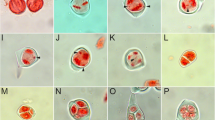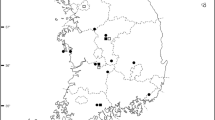Abstract
The meiotic behavior and pollen viability of the tetraploids (2n = 4x = 40) Arachis glabrata and A. nitida were analyzed aiming to provide insights into the nature of these polyploids and into the mechanism that determines the low seed production of these species. Meiotic analysis revealed 21 different chromosome configurations at diakinesis-metaphase I in A. glabrata (from 20 II to 4 II + 8 IV) and 7 in A. nitida (from 20 II to 2 I + 12 II + 2 III + 2 IV). The multivalent associations (up to 8 IV) observed in some A. glabrata metaphases suggest that this species may have an autopolyploid origin. However, the fact that the mean number of bivalents varied among accessions indicates different degrees of diploidization among them. In contrast, the multivalents (up to 2 III + 2 IV) observed in very low frequency in A. nitida indicate that this species may be either a largely diploidized autopolyploid or a segmental allopolyploid. A great diversity, although in low frequency, of meiotic abnormalities (abnormal chromosome orientation and segregation, chromosome bridges, irregular spindles, micronuclei, aneuploid nuclei, restitution nuclei, microcytes, monads, dyads, triads, and hexads) was detected in both species. The meiotic indexes were over 95%, and pollen viabilities ranged from 83.20 to 95.99%. These results suggest that chromosome behavior during meiosis would not severely affect pollen viability. Thus, the irregular chromosome behavior caused by the autopolyploid or segmental allopolyploid nature of these species may not be related to their low seed set production.



Similar content being viewed by others
References
Angelici C, Hoshino AA, Nóbile PM, Palmieri DA, Valls JFM, Gimenes MA, Lopes CR (2008) Genetic diversity in Rhizomatosae section of the genus Arachis (Fabaceae) based on microsatellite markers. Genet Mol Biol 31:79–88
Brandham PE (1970) Chromosome behavior in the Aloineae III correlations between spontaneous chromatid and sub-chromatid aberrations. Chromosoma 31:1–17
Cimini D, Cameron LA, Salmon ED (2004) Anaphase spindle mechanics prevent mis-segregation of merotelically oriented chromosomes. Curr Biol 14:2149–2155
Clark FJ (1940) Cytogenetics studies of divergent meiotic spindle formation in Zea mays. Amer J Bot 27:547–559
Comai L (2005) The advantages and disadvantages of being polyploid. Nat Rev Genet 89:836–846
Darlington CD (1965) Recent advances in cytology. J & A Churchill Ltd., London
Dewitte A, Eackhaut T, Van Huylenbroeck J, Van Bockstaele E (2010) Meiotic aberrations during 2n pollen formation in Begonia. Heredity 104:215–223
Diao WP, Bao SY, Jiang B, Cui L, Qian CT, Chen JF (2009) Cytogenetic studies on microsporogenesis and male gametophyte development in autotriploid cucumber (Cucumis sativus L.): implication for fertility and production of trisomics. Plant Syst Evol 279:87–92
Diggle PK, Meixner MA, Carrol AB, Aschwanden CF (2002) Barriers to sexual reproduction in Polygonum viviparum: a comparative developmental analysis of P. viviparum and P. bistortoides. Ann Bot 89:145–156
Dyer AF (1963) The use of lacto-propionic orcein in rapid squash methods for chromosome preparations. Stain Tech 38:85–90
Fatta Del Bosco S, Tusa N, Conicella C (1999) Microsporogenesis in a Citrus interspecific tetraploid somatic hybrid and its fusion parents. Heredity 83:373–377
French EC, Prine GM, Ocumpaugh WR, Rice RW (1994) Regional experience with forage Arachis in the United States. In: Kerridge PC, Hardy B (eds) Biology and agronomy of forage Arachis. CIAT, Cali, pp 169–186
InfoStat (2008) InfoStat versión 2008. Grupo InfoStat, FCA, Universidad Nacional de Córdoba, Argentina
John B (1990) Meiosis. Cambridge University Press, Cambridge
Krapovickas A, Gregory WC (1994) Taxonomía del género Arachis (Leguminosae). Bonplandia 8:1–186
Lavia GI, Fernández A, Seijo JG (2008) Cytogenetic and molecular evidences on the evolutionary relationships among Arachis species. In: Sharma AK, Sharma A (eds) Plant genome: biodiversity and evolution, vol 1E. Science Publishers, Calcutta, pp 101–134
Luan L, Wang X, Long WB, Liu YH, Tu SB, Xiao XY, Kong FL (2009) A comparative cytogenetic study of the rice (Oryza sativa L.) autotetraploid restorers and hybrids. Russ J Genet 45:1074–1081
Maass BL, Ocampo CH (1995) Isozyme polymorphism provides for germplasm of Arachis glabrata Bentham. Genet Resour Crop Evol 42:77–82
Mallikarjuna N, Sastri DC (2002) Morphological, cytological and disease resistance studies of the intersectional hybrid between Arachis hypogaea L. and A. glabrata Benth. Euphytica 126:161–167
Nicklas RB, Waters JC, Salmon ED, Ward SC (2001) Checkpoint signals in grasshopper meiosis are sensitive to microtubule attachment, but tension is still essential. J Cell Sci 114:4173–4183
Nielsen LR, Siegismund HR, Philipp M (2003) Partial self-incompatibility in the polyploid endemic species Scalesia affinis (Asteraceae) from the Galápagos: remnants of a self-incompatibility system? Bot J Linn Soc 142:93–101
Pagliarini MS (2000) Meiotic behavior of economically important plant species: the relationship between fertility and male sterility. Genet Mol Biol 23:997–1002
Pagliarini MS, Risso-Pascotto C, Souza-Kaneshima AM (2008) Analysis of meiotic behavior in selecting potential genitors among diploid and artificially induced tetraploid accessions of Brachiaria ruziziensis (Poaceae). Euphytica 164:181–187
Pittenger TH, Frolik EF (1951) Temporary mounts for pollen abortion determinations. Stain Tech 26:181–184
Prine GM, Dunavin LS, Moore JE, Roush RD (1981) “Florigraze” rhizoma peanut: a perennial forage legume. Agr Exp Sta, Univ of Florida, Gainsville, Circular S-275
Prine GM, Dunavin LS, Glennon RJ, Roush RD (1986) “Arbrook” rhizoma peanut: a perennial forage legume. Agr Exp Sta, Univ of Florida, Gainsville, Circular S-332
Qu L, Hancock JF, Whallon JH (1998) Evolution in an autopolyploid group displaying predominantly bivalent pairing at meiosis: genomic similarity of diploid Vaccinium darrowi and autotetraploid V. corymbosum (Ericaceae). Amer J Bot 85:698–703
Raman VS (1981) Nature of chromosome pairing in allopolyploids of Arachis and their stability. Cytologia 46:307–321
Ramsey J, Schemske DW (2002) Neopolyploidy in flowering plants. Annu Rev Ecol Syst 33:589–639
Rouse RE, Roka F, Miavitz-Brown EM (2004) Guide for establishing perennial peanut as a landscape groundcover. Proc Fla State Hort Soc 117:289–290
Santos JL, Alfaro D, Sanchez-Moran E, Armstrong SJ, Franklin FCH, Jones GH (2003) Partial diploidization of meiosis in autotetraploid Arabidopsis thaliana. Genetics 165:1533–1540
Seijo JG (2002) Estudios citogenéticos en especies sudamericanas del género Lathyrus, sección Notolathyrus (Leguminosae). Doctoral thesis, Facultad de Ciencias Exactas, Físicas y Naturales, Universidad de Córdoba, Argentina
Seijo JG, Solis Neffa VG (2006) Cytogenetic studies in the rare South american Lathyrus hasslerianus Burk. (Leguminosae). Cytologia 71:11–19
Simpson CE, Valls JFM, Miles JM (1994) Reproductive biology and the potential for genetic recombination in Arachis. In: Kerridge PC, Hardy B (eds) Biology and agronomy of forage Arachis. CIAT, Cali, pp 43–52
Singh AK (1986) Utilization of wild relatives in the genetic improvement of Arachis hypogaea L. Theor Appl Genet 72:433–439
Singh RJ (2003) Plant cytogenetics, 2nd edn. CRC Press, Boca Raton
Stebbins GL (1947) Types of polyploids, their classification and significance. Adv Genet 1:403–429
Taschetto OM, Pagliarini MS (2004) Meiotic behavior in tetraploid populations of Pfaffia tuberosa (Amaranthaceae). Acta Bot Croat 63:17–24
Teng N, Chen T, Jin B, Wu X, Huang Z, Li X, Wang Y, Mu X, Li J (2006) Abnormalities in pistil development result in low seed set in Leymus chinensis (Poaceae). Flora 201:658–667
Valls JFM, Simpson CE (2005) New species of Arachis (Leguminosae) from Brazil, Paraguay and Bolivia. Bonplandia 14:35–64
Valls JFM, Maas BL, Lopez CR (1994) Genetic resources of wild Arachis and genetic diversity. In: Kerridge PC, Hardy B (eds) Biology and Agronomy of Forage Arachis. CIAT, Cali, pp 28–40
Acknowledgments
This work was supported by grants from Secretaría General de Ciencia y Técnica (UNNE) PI 47/04, Consejo Nacional de Investigaciones Científicas y Técnicas (CONICET) PIP 6265, and Agencia Nacional de Promoción Científica y Tecnológica PICTO 2007-00099, Argentina.
Author information
Authors and Affiliations
Corresponding author
Rights and permissions
About this article
Cite this article
Ortiz, A.M., Seijo, J.G., Fernández, A. et al. Meiotic behavior and pollen viability of tetraploid Arachis glabrata and A. nitida species (Section Rhizomatosae, Leguminosae): implications concerning their polyploid nature and seed set production. Plant Syst Evol 292, 73–83 (2011). https://doi.org/10.1007/s00606-010-0397-8
Received:
Accepted:
Published:
Issue Date:
DOI: https://doi.org/10.1007/s00606-010-0397-8




